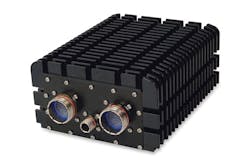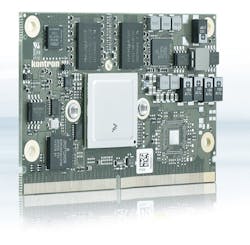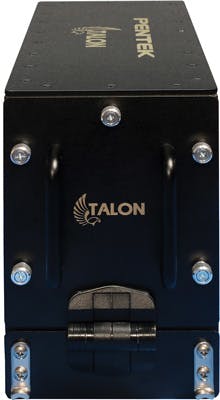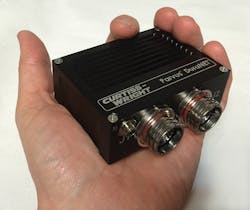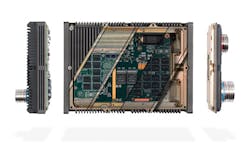It's not just about small size, weight, power consumption, and cost anymore, as efficient processors, fast data conversion, and optical interconnects help designers look at systems in a whole new way.
Military embedded computing systems perhaps are more susceptible than any other components to demands for small size, weight, power consumption, and cost - collectively known as SWaP-C. Standard board-and-backplane architectures like 3U VPX have tried to meet the SWaP-C demands of systems designers, but it's still not enough.
Enter small-form-factor embedded computing - SFF, for short. This embedded computing design approach involves board standards like COM Express and Mini COM Express, PCI/104 Express, the Smart Mobility ARChitecture (SMARC), and Mini Embedded Technology eXtended (Mini-ETX), as well as proprietary SFF form factors like those from Gumstix Inc. in Portola Valley, Calif.
These tiny embedded processors and peripherals rarely, if ever, depend on a backplane architecture, and can implement tiny systems as small as one board. The modules themselves often can be as small as a credit card, or even a stick of gum, which opens up a broad variety of embedded computing implementations in wearable systems, small unmanned aerial vehicles (UAVs), mobile communications systems, vehicle electronics (vetronics), and many other systems that require extremes in small size, weight, and power consumption.
The drive for SWaP
It's no secret that military systems designers want to pack as much computing power as they can into applications of virtually every size and shape. Moreover, designers are trying to shoe-horn embedded computing into applications that never required it before for tasks like sensor processing, voice and data networking, graphics capabilities, and fast data recording.
They often can get all this with small-form-factor embedded computing. "Customers are looking at functionality, data storage, and processing requirements, and they are more keen on meeting requirements than they are on the board-level architecture within the system," says Mike Southworth, product manager at Curtiss-Wright Defense Solutions in Salt Lake City. "Minimizing size, weight, power, and cost is more important than the architecture."
This is particularly true in applications where traditional board-and-backplane architectures may be difficult or impossible to use. "If you're designing a UAV, you are counting ounces as a budget for payload weight," explains Rodger Hosking, vice president of embedded computing specialist Pentek Inc. in Upper Saddle River, N.J. "You will be very interested in getting anything smaller and lighter. The cost of size and weight is at a premium."
Military land vehicles like the Humvee and future Joint Light Tactical Vehicle (JLTV) also are prime candidates for small-form-factor embedded computing. These used to be considered to be only for soldiers and Marines, weapons, and ammunition. Today they are much more.
The modern military land vehicle today is a communications node, sensor platform, battery charger, and mobile rugged computer server room, in addition to transporting warfighters and fire power. As land vehicles become smaller and lighter, and as their demand for computers and other electronics grows, military commanders are competing for on-board space to accommodate personnel as well as electronics.
Finding room for both is becoming a big challenge. "At one of the VICTORY meetings an Army general said, 'I need more room for my soldiers' feet to drive the vehicle," says Bret Farnum, vice president of sales at Extreme Engineering Solutions (X-ES) in Middleton, Wis. VICTORY describes a standard vetronics architecture and stands for Vehicle Integration for C4ISR/EW Interoperability.
Emphasis on standards
In these kinds of applications designers often find it worthwhile to place a higher priority on SWaP-C than on traditional embedded computing architectures like 6U and 3U VPX or PCI Express. "In military and aerospace applications we see that many systems integrators are becoming slightly less concerned with industry-standard form factors," says Stuart Heptonstall, product manager for graphics systems at Abaco Systems in Huntsville, Ala. "They are looking to get a specific computing job done in a small space where low SWaP is the aim of the game. If that means trading an industry standard to get the SWaP they need, they'll go right ahead."
Engineers at Kontron America in Poway, Calif., used the small-form-factors approach when they designed a satellite modem for Hughes Communications in Germantown, Md., for use in a wide range of airborne applications. The modem is based on the fanless Kontron COBALT 901 rugged embedded computer with the Intel Core i7 dual-core microprocessor.
"The packaging was made possible by the COM Express board, which we now are qualifying for shock and vibration, temperature, and electronic emissions. It's a full Mil-810 system," says Mark Littlefield, vertical product manager for defense products at Kontron. "In the past we had a single-board computer and an array of peripherals, and built with a series of blades in a chassis. Small-form-factor offers an off-the-shelf module you can use on a COTS carrier, as well as the ability to add very compact peripherals like Mini PCI Express boards for ARINC 429 or 1553 data buses or solid-state drives. With standard COM-Express board and compact carrier card you can build very compact computing with a lot of options."
Using small sizes, weights, and levels of power consumption have been a design rule for quite some time in aerospace and defense applications. In some new systems, as well as in upgrades to small existing systems, designers simply cannot count on the availability of large spaces for traditional computer boxes. "In many cases, the end product itself is also a bespoke shape, so industry-standard SFF boards do not always fit the slot," Heptonstall adds.
Military land vehicles
Military land vehicles like the JLTV are a case in point, says X-ES's Farnum. "Take a larger 3U VPX system and compare it to our XPand6052 SFF system, which is one-third the size of a 3U system. It is only two inches tall and hosts COM Express, so designers can distribute and shoehorn them in different pockets on the vehicle."
X-ES is focusing on land vehicles as a market opportunity for small form factors, as well as on small aircraft like UAVs, helicopters, and sensors packaged in airborne pods.
Designers at Curtiss-Wright relied on small-form-factor PC/104 to craft a miniature Ethernet switch for a constrained-payload application aboard a medium-sized UAV. "That box was considerably smaller than our competition, but was larger than what the customer could support," says Curtiss-Wright's Southworth. "They could accommodate half a pound of weight, and about the size of a pack of cigarettes. We adapted PC/104 to something even smaller, and the new box was about 10 cubic inches."
Similarly, Pentek is designing a new data recorder and new signals- acquisition system based on COM Express carrier cards that can accept field-programmable gate array (FPGA) processors packaged on Switched Mezzanine Card (XMC) or FPGA Mezzanine Card (FMC) modules. Such an architecture is not be limited to COM Express carrier cards, but also could accommodate PC/104, Mini PCI Express, or Mini ETX, Hosking says.
The new Pentek small-form-factor data recorders and data-acquisition systems feature FPGAs as their core technology, and high-speed wideband analog-to-digital (A/D) converters and digital-to-analog (D/A) converters to translate RF signals to digital data streams. One big enabling technology for these systems is the Zynq system-on-chip (SoC) from Xilinx Inc. in San Jose, Calif., Hosking explains. "It includes the multicore ARM processor and FPGA, all on the same silicon. Now we have a combination of resources for FPGA for high-speed DSP [digital signal processing], and a processing engine to manage all system control functions."
Design tradeoffs
There are design tradeoffs involved with moving designs into the smallest realms possible. Where small form factors offer relatively small SWaP-C, using this approach gives up the reliability, established thermal management, extremely high computer power, broad industry support, and upgradeability of something like a 3U VPX board-and-backplane architecture.
Those who choose SFF embedded computing over modular board-and-backplane systems typically are looking at purpose-built systems with limited capacity for upgrades, experts say. "In small form factor, customers really are not as driven by the mandate for standards as they are for larger systems such as VPX," Hosking says.
Small form factors trade small size and low cost for a relative lack of upgradeability. "In small form factors you are looking more or less at a dedicated function that is unlikely to be upgraded," Hosking says. "The cost to replace it is not such a big hurdle, since its up-front cost is not as expensive as a VPX system."
It all boils down to the application, Hosking says. "The advantages of 3U VPX is a modular open-standard board system with replaceable modules that can be upgraded and configured, with a longer life cycle than a dedicated processor box. There is a place for both; it depends on the mission."
3U VPX and similar architectures have the advantage of a databus, says X-ES's Farnum. "Depending on what you put inside a VPX chassis, you can put two to six different types of boards in a half-ATR tray. That gives you two CPUs, switch and router, some custom I/O like MIL-STD-1553, or special Ethernet connectivity. You can fit everything in one box."
Although small form factors may not be able to accommodate the industry's most powerful processors, at least not yet, there are plenty of SWaP-constrained military applications in which processors that dissipate no more than 80 watts are more than good enough. "Sometimes you can get by with a smaller system and still have plenty of processing power," says Kontron's Littlefield.
All factors being equal, designers most likely will opt for a standard board-and-backplane architecture, says Abaco's Heptonstall. "If there is an industry-standard form factor product that meets the requirement, then that still would be generally preferable, as it has the potential lower time-to-market and risk."
The small form factors
Industry experts say there is no clear consensus on the right small form factors for military embedded computing. Still, companies do have their preferences. Designers prefer components that adhere to some sort of industry standard over custom-designed form factors - unless nothing standard can meet requirements.
"Customers prefer standards where they're available and will do the job, because they allow better leverage of development and procurement dollars as they span many vs. few applications without redesign," says Ben Daniel, general manager of the avionics business at Abaco Systems. "That said, we do still see custom versions, all the way down to core and component integration onto application-specific solutions."
Although it's too early to tell, COM Express may be emerging as the default for SFF embedded computing for a variety of reasons, including industry familiarity, a growing installed base, an inherent resistance to shock and vibration, and ability to keep the boards cool.
"COM Express is gaining significant sway in the military and aero- space area," says Curtiss-Wright's Southworth. Echoes Littlefield of Kontron, "I was surprised at how much interest there is in COM Express and other form factors in aerospace and defense applications."
Military applications especially may be suitable for COM Express integration because of the way the modules can be cooled, says X-ES's Farnum. "The best thing about COM Express is when you mount a module, all the heat moves outward. It's much superior in that it is easier to cool."
COM Express also is proving itself to be a match for applications subject to physical abuse. "COM Express and its mounting and connector technology are much more stable than a PC/104 stack when subjected to shock, and vibration," Farnum says.
That's not to say that competing small form factors are losing out in aerospace and defense applications. "We have been doing PC/104 and PCI/104 for years, and still see both civil and military using those for small SWaP systems," says Abaco's Daniel.
Distributed systems
Perhaps one of the most exciting aspects of small-form-factor embedded computing is the technology's ability to be distributed throughout a system or platform, enabling designers to locate components where they fit and where it makes the most sense.
Pentek's Hosking points out that the convergence of small-form-factor embedded computing, powerful A/D and D/A converters, the growing availability of high-speed optical fiber interconnects, and the growing power of efficient microprocessors and FPGAs may help systems designers look at systems in a whole new way. He gives the example of RF antennas packed tightly together on the mast of a military ship. By blending small form factors and fast optical fiber interconnects, designers might consider placing A/D converters and pre-processor FPGAs as closely to the antennas as possible, and linking the signal via fiber to computer centers on the interior of the ship.
Optical fiber, Hosking says, is immune to RF noise and can help alleviate problems with shipboard co-site interference, where closely spaced transmit and receive antennas cause noise and distortion for one another.
Distributing embedded computing throughout a platform using small form factors also has its tradeoffs. Signal integrity and cybersecurity take on bigger roles with distributed systems, and secure networking can introduce technological complexity. Still, the potential payoffs may be well worth it. "A pool of processing resources you can retask to whatever tactical situation you might have is a real active dream," says Kontron's Littlefield. "If people aren't doing distributed architectures today, then they are thinking about it."
